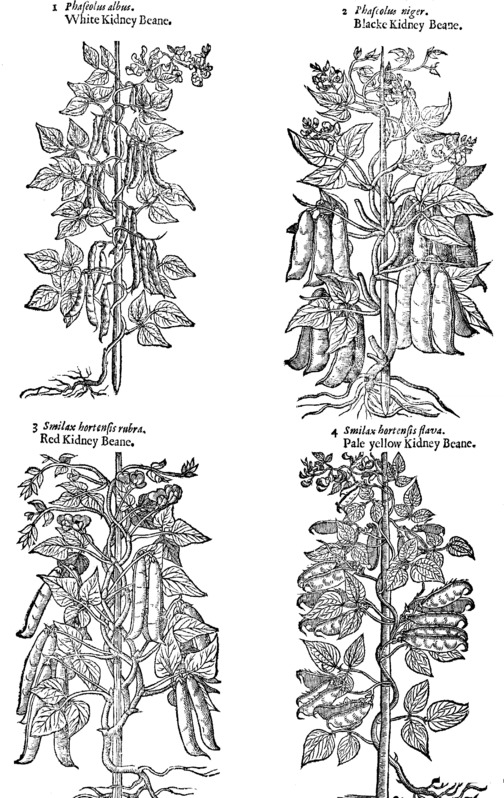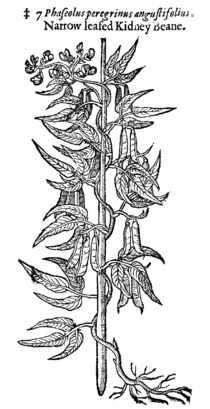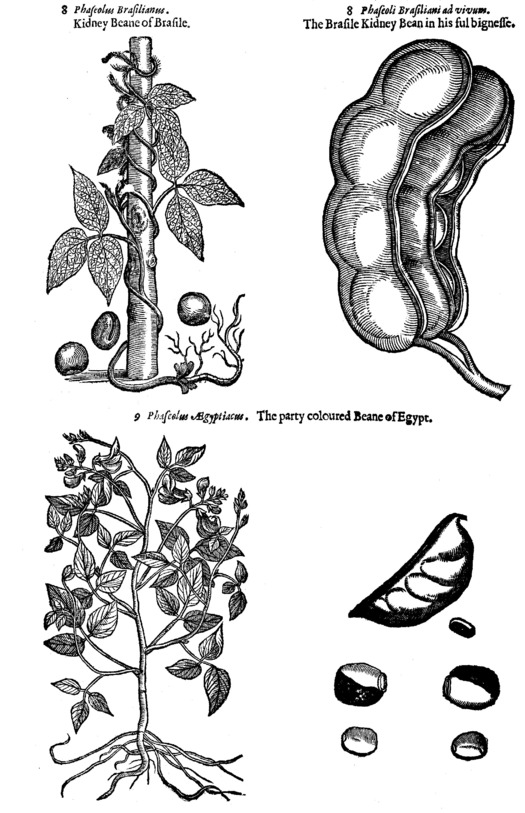
Gerard's Herbal

Fig. 1723. Kinds of Kidney Bean (1-4)
The Kinds.
The stock or kindred of the Kidney Bean are wonderfully many; the difference especially consisteth in the colour of the fruit: there be other differences, whereof to write particularly would greatly stuff our volume with superfluous matter, considering that the simplest is able to distinguish apart the white Kidney Bean from the black, the red from the purple, and likewise those of mixed colours from those that are only of one colour: as also great ones from little ones. Wherefore it may please you to be content with the description of some few, and the figures of the rest, with their several titles in Latin and English, referring their descriptions unto a further consideration, which otherwise would be an endless labour, or at the least needless.
The Description.
1. The first kind of Phaseolus or garden Smilax hath long and small branches growing very high, taking hold with his clasping tendrils upon poles and sticks, and whatsoever standeth near unto him, as doth the hop or vine, which are so weak and tender, that without such props or supporters they are not able to sustain themselves, but will run ramping on the ground fruitless. Upon the branches do grow broad leaves almost like Ivy, growing together by three, as in the common Trefoil or Three-Leaved Grass: among which come the flowers, that do vary and differ in their colours, according to the soil where they grow, sometimes white, sometimes red, and oftentimes of a pale colour: afterwards there come out long cods, whereof some are crooked, and some are straight, and in those the fruit is contained, smaller than the common Bean, somwhat flat, and fashioned like a kidney, which are of divers colours, like unto the flowers whereto for the most part these are like.
2. There is also another Dolichus or Kidney Bean, lesser, shorter, and with smaller cods, whose flowers and fruit are like in form to the former Kidney Beans, but much lesser, and of a black colour.
3. There is likewise another strange Kidney Bean, which doth also wind itself about poles and props near adjoining, that hath likewise three leaves hanging upon one stem, as have the other Kidney Beans, but every one is much narrower and also blacker: the cods be shorter, plainer, and flatter, and contain fewer seeds.
4. This Kidney Bean differeth not from the others, but only in the colour of the fruit, which are of a pale yellow colour, wherein conlsisteth the difference.
Besides the varieties of these Kidney Beans mentioned by our author, there are divers other reckoned up by Clusius, which have been brought out of the East and West Indies, and from some parts of Africa; I will only give you the figures of two or three of them out of Clusius, with the colours of their flowers and fruit.
5. The stalk of this is low and stiff, the flowers of a whitish yellow on the outside, and of a violet colour within: the fruit is snow white, with a black spot in the eye: This is Phaseolus peregrinus 4 Of Clusius.
6. This hath leaves like the Marsh Trefoil, flowers growing many together, in shape and magnitude like those of common Pea: the cods were narrow, and contained three or four seeds, which were small, no bigger than the seeds of Laburnum: the painter expressed two of them in the leaf next under the uppermost tuft of flowers: this is Clusius his Phaseolus peregrinus 5.

Fig. 1726. Narrow-Leaved Kidney Bean (7)
7. This grows high, winding about poles or other supporters: the leaves are narrower than the former: the fruit lesser and flatter, of a reddish colour. This is the Phaseolus peregrinus 6 of Clusius.

Fig. 1727. Kinds of Kidney Bean (8,9)
8. This winds about poles and grows to a great height, with soft hairy leaves and large cods, wherein are contained seeds of divers colours; sometimes they are red, otherwhiles of a whitish ash colour, sometimes wholly black, and otherwhiles spotted.
9. The Egyptian Bean is somewhat like the other Kidney Beans in his growing: his fruit is of the bigness of a small Hazelnut, black on one side, and of a golden yellow or orange colour on the other.

Fig. 1728. Kinds of Kidney Bean – Fruit only
Besides these you find here figured, and divers others described by Clusius, I think it not amiss to mention two more. The first of these, which was procured by Mr Tradescant, and grows in our gardens, is a large plant, not differing in manner of growth from the former Indian Kidney Beans, but his flowers are large, many, and of an elegant scarlet colour: whence it is vulgarly termed by our Florists, the Scarlet Bean. The other I have seen grow to a little height, but it would not endure; but the cods of it which were brought to us were some three inches long, and covered with a hairy down of a reddish colour, which put upon the hands or skin in any part of the body would sting like a Nettle, ahd this was called the Stinging Bean: I think it came from some part of the East Indies.
The Place
Kidney Beans do easily and soon spring up, and grow into a very great length, being sown near to long poles fastened hard by them, or hard by arbors or banqueting places, otherwise they lie flat on the ground, slowly come up, hardly bring forth fruit, and become faulty and smitted, as Theophrastus writeth.
The Time.
It is sown in the spring, especially in the midst of April, but not before: the fruit is ripe about the end of summer.
The Names.
Hippocrates, Diocles, Theophrastus, and most of the other old Writers do call it Siliche; divers of the bigness of the seed do name it Lekon and Lekion: in Latin, Siliqua: Dioscorides calleth it Smilax, because it climbeth up as Smilax doth, and taketh hold of props, stakes, and shrubs standing near unto it: others name it Phasiolon, a diminutive derived from Phaselos: for Phaselos and Phaseolos are not one and the self-same pulse called by divers names, as some suppose, but sundry fruits one differing from the others; as Galen in his first book Of The Faculties of Nourishments doth sufficiently declare, where he entreateth of them both. For first he disputeth of Phaseli and Ochri, Beans, and Peas; then afterward, others coming between, he writeth of Dolichus, which also is named Phaseolus: and though he may be thought to doubt what manner of pulse that is which Theophrastas calleth Dolichus, notwithstanding he gathereth and concludeth that it is a fruit of a garden plant in Italy, and in Caria, growing in the fields, which is in form longer than the Chicklings, and was commonly called in his time Faseolus. Of his opinion is Paulus Ægineta, writing of Phaselus, which he nameth Dolichus, in the 9th chap of his first book. Moreover, Faselus was in times past a common pulse in Italy and Rome, and Dolichus a strange pulse; for Columella and Palladius, writers of husbandry, have made mention of the sowing of Phaselus: and Virgil calleth it Vilis in the first of his Georgics: but concerning the sowing of Dolichus or Kidney Bean, none of the Latins have written, by reason that the same was rare in Italy, and sown only in gardens, as Galen hath affirmed, naming it oftentimes a garden plant, and showing that the same, as we have said, is sown in Caria; and likewise Dioscorides nameth it Smilax chortea, that is to say Smilax hortensis, or garden Smilax, because it groweth in gardens:
who also writing of this in another several chapter, showeth plainly, that Smilax hortensis, or Dolichus is another plant differing from Faselis, which he nameth Phaseolus.
For which causes it is not to be doubted, but that Phaselus with three syllables, differeth from Faseolus with four syllables, no otherwise than Cicer, Cicercula, and Cicera differ, which notwithstanding be near one to another in names: and it is not to be doubted but that they are deceived, who think it to be one and the self-same Pulse called by sundry names.
This plant is named in English, Kidney Bean, Sperage Beans: of some, Faselles, or Long Peas, French Beans, Garden Smilax, and Roman Beans: in French, Feves de Romme: in Dutch, Turcksboonen.
The Temperature.
Kidney Beans, as Dioscorides teacheth, do more loose the belly than Peas; they are less windy, and nourish well, and no less than Peas, as Diocles saith: they be also without engendering windiness at all: the Arabian physicians say that they are hot and moist of nature.
The Virtues.
A. The fruit and cods of Kidney Beans boiled together before they be ripe, and buttered, and so eaten with their cods, are exceeding delicate meat, and do not engender wind as the other Pulses do.
B. They do also gently loose the belly, provoke urine, and engender good blood reasonably well; but if you eat them when they be ripe, they are neither toothsome nor wholesome. Therefore they are to be taken whilst they are yet green and tender, which are first boiled until they be tender; then is the rib or sinew that doth run alongst the cod to be taken away; then must they be put into a stone pipkin, or some other vessel with butter, and set to the fire again to stew, or boil gently: which meat is very wholesome, nourishing, and of a pleasant taste.